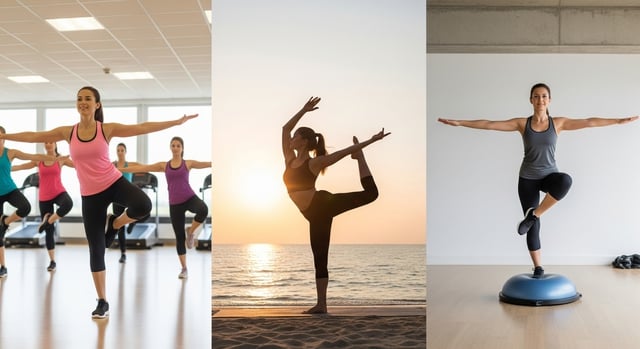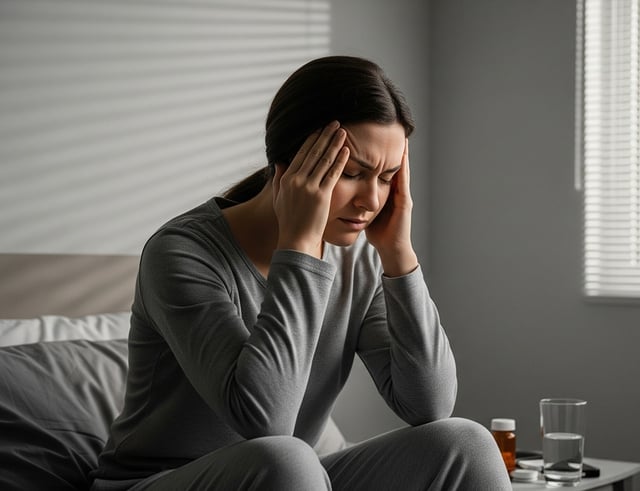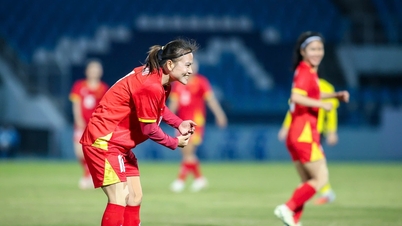Aerobic
Aerobic exercises are exercises that mainly involve large muscle groups in the arms and legs, increasing heart rate and breathing. This type of exercise can be beneficial for migraine sufferers because it reduces inflammation, a factor that often contributes to the pain, according to Verywell Health (USA).

Balance exercises like yoga also have a positive effect on migraines.
PHOTO: AI
In fact, there are many forms of exercise that are generally called aerobic, including:
- Play basketball, soccer, tennis, hockey.
- Cycling, jogging, brisk walking, swimming, jumping rope.
- Dancing.
- Roller skating, skiing.
- Doing housework or gardening requires a lot of energy.
A meta-analysis analyzed 10 relevant studies with 508 participants, and found that aerobic exercise significantly reduced pain intensity, number of days with pain, and pain duration.
Strength training, weight training
These exercises help increase muscle strength, endurance, and resistance. Some studies show that they can reduce the severity of migraine headaches.
In one study, women with migraines were divided into two groups: One group participated in an eight-week muscle-training program, and the other group did not. Results showed that the exercise group had significantly reduced headache severity, duration, and frequency; and improved quality of life and muscle strength.
Some experts suggest starting with a weight that is about 50% of your maximum capacity, performing 2-3 sets of 12-15 reps, 3 times a week. Once you are used to 3 sets, you can increase the weight by about 5% each week, alternating with light exercise or recovery days to give your body time to regenerate.
Remember to warm up and stretch for 10 minutes before and after exercise; the ideal time for a session can be from 45-60 minutes.
Balance and flexibility exercises
Exercises that improve balance and flexibility are important for overall health and can help prevent migraines. Some common forms include: stretching, tai chi, yoga…
A study showed that people who often suffered from migraines did yoga at home for 1 hour, 3 times a week, continuously for 3 months. The result was that the yoga group reduced the number of headaches by 50%, especially reducing the amount of pain medication needed by half compared to the group that did not practice.
Notably, balance and flexibility exercises can help relieve symptoms even if the exerciser is experiencing a migraine during the exercise.

However, over-exercising or exercising inappropriately can aggravate migraine attacks in some people.
Photo: AI
How does exercise help migraine sufferers?
Research shows that regular exercise can reduce the frequency and severity of migraine attacks. There are several theories about this link:
Natural pain relief : When exercising, the body produces endorphins, a neurotransmitter considered the body's "natural pain reliever", which helps relieve pain and improve mood.
Reduce inflammation : During exercise, the body releases anti-inflammatory substances, helping you sleep better, reduce stress, thereby somewhat limiting the onset of migraines.
Increase lean muscle mass : Building strong muscles is also thought to help reduce the frequency of migraines. A higher percentage of lean muscle is associated with fewer headaches.
In addition, exercise has been shown to improve many other health conditions linked to migraine risk, such as insomnia, obesity, and depression.
Training duration and things to know
The general recommended exercise time for adults is:
- 150 minutes/week of moderate-intensity exercise (can be divided into several sessions).
- Incorporate muscle-strengthening exercises (like weight training) twice a week.
However, in some people, overtraining can be a trigger for migraines. This may be due to the release of certain chemicals that trigger migraines during strenuous exercise – such as hypocretin, lactate, and CGRP.
Exercising during a headache also increases your heart rate and blood flow to the brain, which can make headache symptoms worse.
On the other hand, if you've ever had a migraine after exercising , consider whether there are other factors involved - like the smell of the gym, the harsh sunlight outside... - because sometimes exercise isn't the culprit.
People can also try changing the form of exercise, reducing the intensity and monitoring what works best for their body, from there making timely adjustments.
Source: https://thanhnien.vn/3-cach-van-dong-co-the-cho-nguoi-de-bi-dau-nua-dau-18525072015324665.htm





![[Photo] Cat Ba - Green island paradise](/_next/image?url=https%3A%2F%2Fvphoto.vietnam.vn%2Fthumb%2F1200x675%2Fvietnam%2Fresource%2FIMAGE%2F2025%2F12%2F04%2F1764821844074_ndo_br_1-dcbthienduongxanh638-jpg.webp&w=3840&q=75)
![[Photo] 60th Anniversary of the Founding of the Vietnam Association of Photographic Artists](/_next/image?url=https%3A%2F%2Fvphoto.vietnam.vn%2Fthumb%2F1200x675%2Fvietnam%2Fresource%2FIMAGE%2F2025%2F12%2F05%2F1764935864512_a1-bnd-0841-9740-jpg.webp&w=3840&q=75)








































































































Comment (0)